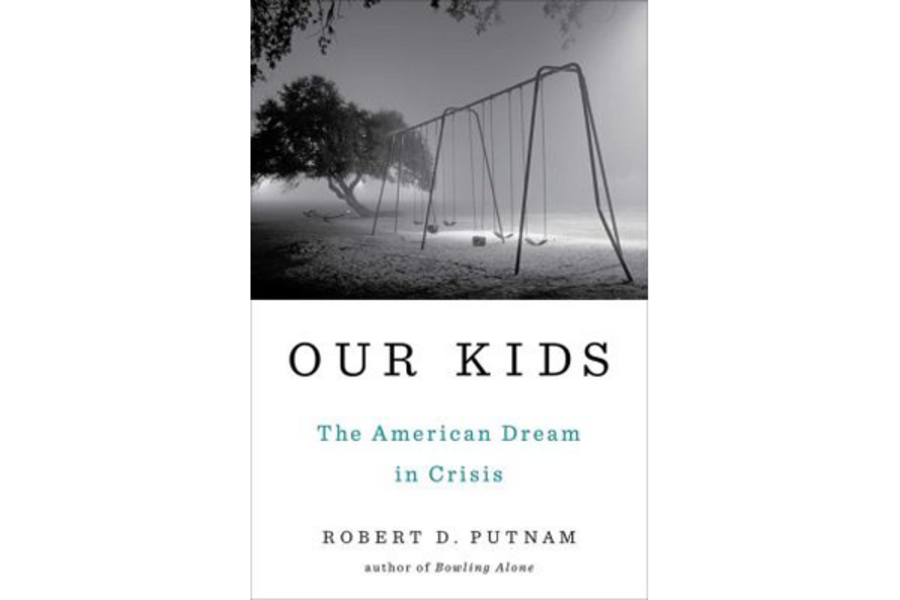'Our Kids' suggests an American dream out of reach for many
Loading...
Has the American Dream become a myth? Is the poor kid who studies hard, works his way up, and achieves success, more legend than reality?
Robert D. Putnam claims that American-Dream-style upward mobility “has stalled” and that there has been a “steady deterioration of the economic circumstances of lower-class families, especially compared to the expanding resources available to upper-class parents.”
A public policy professor at Harvard University, Putnam has written extensively about the dynamics of American society. He says that “[g]raphically, the ups and downs of inequality in America during the twentieth century trace a gigantic U, beginning and ending in two Gilded Ages.” He argues that there was “a long period of relative equality around mid-century” but he sees little trace of that today.
Putnam starts his new book Our Kids: The American Dream in Crisis by making a “Back to the Future”-style visit to his childhood home town of Port Clinton, Ohio, where he graduated from high school in 1959. He examines how that community has changed, and how the gap there between rich and poor – financially, socially and educationally – has widened since the 1950s.
In absorbing profiles Putnam recounts the trajectories of the lives of several people he grew up with. Looking at his own generation, he says “upward mobility among the kids from the lower half of the socioeconomic hierarchy was almost as great as among the most privileged kids.” But today, after losing manufacturing jobs and downtown shops emptying in favor of Family Dollar and Walmart, this small city has bifurcated into a wealthy, privileged class versus families struggling to remain viable.
Chelsea, from an affluent family living in a large home overlooking Lake Erie with supportive parents, now has a graduate degree. By contrast David, whose dad is in prison and whose mom he rarely saw growing up, “has had to fend for himself his entire life.” He wants to get more education and steady his tumultuous life, but feels stuck in dead-end jobs.
Putnam profiles a variety of families from other American communities in “Our Kids” –- all to illustrate that “[t]he disadvantages facing poor kids begin early and run deep.” And that “kids from affluent, educated homes get the best of both worlds – more monetary investment ... and more time investment [parental involvement].”
Putnam anecdotally and statistically shows that kids in well-off families benefit from high-quality schools, safe neighborhoods, helpful mentoring connections, enriching extracurricular activities.... the list goes on and on. Yes, some of the parents in Putnam’s profiles of struggling families have made bad decisions. But he implies that in a world like the one he grew up in in the 1950s, with stable jobs and supportive communities, and where far fewer children were born to poor, unmarried moms, kids would not be growing up in chaos.
Putnam has once again written a book that helps America understand itself – where, as a society, it’s going, where it’s been, and what traditional strengths it must find new ways to preserve and restore.
He is a master of making statistics tell a convincing story. In his bestselling book from 2000, “Bowling Alone: The Collapse and Revival of American Community,” he employed a giant body of information to argue the United States is being weakened by a gradual collapse of social connections.
“Bowling” is eclipsed in poignancy by “Our Kids,” thanks to the personal profiles Putnam includes. He is a convincing and clear writer, able to turn a phrase to display his argument in sharp relief.
It’s no news flash that many children in America today face obstacles to success. But Putnam demonstrates these obstacles have gotten worse. America’s changed economy has undermined workers who relied on bread-and-butter employment, and hasn’t, so far, created a paradigm where working-class families can restart their lives.
In his “What is to be Done” chapter Putnam makes recommendations. These include ideas for reducing “nonmarital birth rates,” for government policies that put more money in the pockets of poor parents, and for reducing incarceration for non-violent crime, freeing dads to be dads. He advocates for high-quality day care and preschool education.
With regard to schools, he recommends recruiting better teachers and extending school hours to offer more enriching activities. Furthermore, he argues for strengthening vocational and apprenticeship training for non-college-bound young people.
Finally, he returns to a “Bowling Alone” theme, and concludes this important and worthy book by suggesting steps to strengthen and revitalize neighborhoods.








